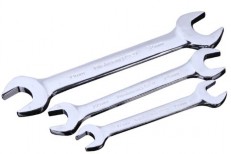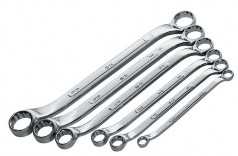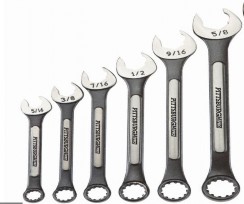collection of wrenches. This includes both metricand SAE wrenches in a variety of sizes and styles. The width of the jaw opening determines its size. For example, a 1⁄2-inch wrench has a jaw opening of 1⁄2 inch. The size is actually slightly larger than its nominal size so the wrench fits around a nut or bolt head of equal size.
The following is a brief discussion of the types of wrenches used by automotive technicians.
Figure 1.4 Open-end wrench
Figure 1.5 Box-end wrench | |
Combination Wrench The combination wrench (Figure 1.6) has an open-end jaw on one end and a box-end on the other. Both ends are the same size. Every auto technician should have two sets of wrenches: one for holding and one for turning. The combination wrench is probably the best choice for the second set. It can be used with either open-end or box-end wrench sets and can be used as an open-end or box-end wrench. |
Figure 1.6 Combination wrench |
Có thể bạn quan tâm!
-
 Anh văn chuyên ngành Nghề Công nghệ ô tô - CĐ TC - Trường Cao đẳng nghề Đồng Tháp - 1
Anh văn chuyên ngành Nghề Công nghệ ô tô - CĐ TC - Trường Cao đẳng nghề Đồng Tháp - 1 -
 The Starter Motor Draws A Great Deal Of Current From The………….. A Large Starter Motor Might Require 250 Or More Amperes Of Current. This Current Flows
The Starter Motor Draws A Great Deal Of Current From The………….. A Large Starter Motor Might Require 250 Or More Amperes Of Current. This Current Flows -
 The Liquid Gets Into The Radiator Through…………….. It Is Usually Mounted On The Top Of The Radiator.
The Liquid Gets Into The Radiator Through…………….. It Is Usually Mounted On The Top Of The Radiator. -
 Anh văn chuyên ngành Nghề Công nghệ ô tô - CĐ TC - Trường Cao đẳng nghề Đồng Tháp - 5
Anh văn chuyên ngành Nghề Công nghệ ô tô - CĐ TC - Trường Cao đẳng nghề Đồng Tháp - 5
Xem toàn bộ 97 trang tài liệu này.
Allen (or hex) wrench
Some of the screws on your vehicle may have odd shaped holes in the centers of their heads that require special Allen wrenches. They are L-shaped rods that fit into the holes. If the center hole is hexagonal, the wrench you need is sometimes called a hex wrench (Figures 1.7)
Adjustable wrench
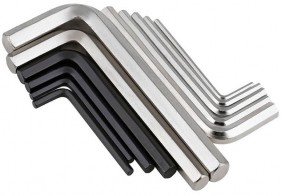
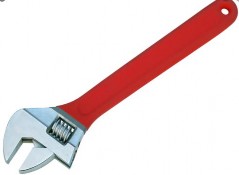
An adjustable wrench (Figure 1.8) has one fixed jaw and one movable jaw. The wrench opening can be adjusted by rotating a wheel. Because this type of wrench does not firmly grip a bolt’s head, it is likely to slip. Adjustable wrenches should be used carefully and only when it is absolutely necessary.
Figure 1.8 Adjustable wrench |
4. Sockets and Ratchets
A set of sockets (Figure 1.9) combined with a ratchet handle and a few extensions should be included in your tool set. The ratchet allows you to turn the socket in one direction with force and in the other direction without force, which allows you to tighten or loosen a bolt without removing and resetting the wrench after you have turned it. In many situations, a socket wrench is much safer, faster, and easier to use than any other wrench.
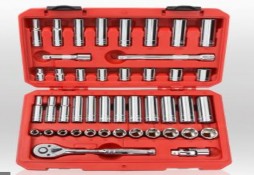

Figure 1.10 Torque wrench |
5. Torque wrench
A torque wrench (Figure 1.10) is basically a ratchet with some means of displaying the amount of torque exerted on a bolt when pressure is applied to the handle. Torque wrenches are available with the various drive sizes. Sockets are inserted onto the drive and then placed over the bolt. As pressure is exerted on the bolt, the torque wrench indicates the amount of torque.
6. Pliers
Pliers are gripping tools used for working with wires, clips, and pins. At a minimum, an auto technician should own several types: standard pliers for common parts and wires, needle-nosed pliers for small parts, and large, adjustable pliers for large items and heavy-duty work.
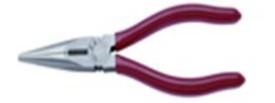
Figure 1.12 Slip-joint pliers |
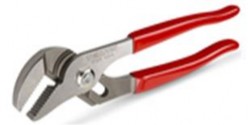
7. Taper and flat feeler gauges
You use taper feeler gauges for gapping spark plugs. Gapping means sliding the proper-sized wire or taper gauge between the spark plug electrodes to make sure that the surfaces are the proper distance apart. Doing so ensures that the spark can jump across the gap with the proper intensity. You use Flat feeler gauges to adjust valves and ignition contact points (Figures 1.13 & 1.14).
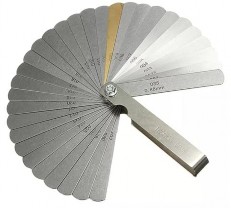
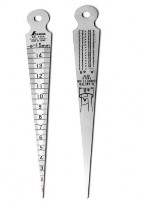
Figure 1.14 Taper feeler gauge |
8. Compression gauges
You use compression gauges to check the pressure that builds up in each cylinder as your engine runs. These gauges also reveal worn or damaged piston rings and valves.
9. Jacks
Most new cars come with a jack to be used when changing tires. There are two types of jacks: scissor jack and hydraulic jack (Figure 1.15& 1.16).
10. Jack Stands
If you plan to work under your vehicle, you also need a pair of jack stands. With these, you jack upthe car, place the jack stands under the car close to where the jack is, and then remove the jack so that the weight of the vehicle rests on the jack stands, and not on the jack, which can collapse. The stands keep the car off the ground with less danger of slipping and enable you to jack up more than one side of the vehicle at a time (Figure 1.16).
11. Creepers
If you’re going to spend a lot of time under your vehicle, you may want a creeper, which is just a board with casters under it. You lie on it and move around easily (Figure 1.17).
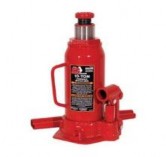
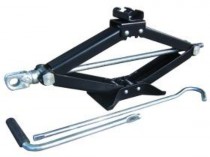
Figure 1.16 A scissor jack | |
Figure 1.17 Jack stands | Figure 1.18 A creeper |
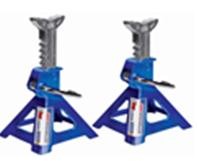
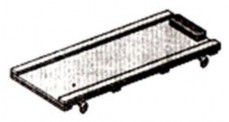
Task 1 Match the underlined words from the text with the correct definitions
………………... ………………... ………………... ………………... ………………... ………………... ………………... ………………... |
Task 2 Read the text and say if these statements are True (T) or False (F)
…………... …………... …………... …………... …………... …………... …………... |
…………... |
8. Mechanics can measure worn piston rings and valves by
Task 3 Fill in each blank with a suitable word or phrase from the text
1. You use these gauges to adjust valves and ignition contact points. They are
……………..
2. The type of pliers that is used to work on small parts of machine is
………….....
3. The two types of screwdrivers that a mechanic should have are standard, or slot screwdrivers and ……………...
4. After jacking up the car with a hydraulic jack, you have to use a
………………….to support the weight of the car and take off the jack.
5. A ………………….. is designed to tighten a nut, bolt, or screw to an exact degree.
6. We use ……………….. to check the pressure that builds up in each cylinder as your engine runs.
7. A ………………is faster and safer than a scissor jack.
8. With the ……………………., we can adjust the jaws to fit a variety of nuts and bolts simply by turning the wheel.
9. We have to use an …………………………..to tighten or remove some of the screws that have odd shaped holes in the centers which are usually hexagonal.
Task 4 Translate into Vietnamese
1. A set of sockets combined with a ratchet handle and a few extensions should be included in your tool set. The ratchet allows you to turn the socket in one direction with force and in the other direction without force
…………………………………………………………………………………………
…..……………………………………………………………………………………
………..………………………………………………………………………………
……………..………………………
2. If you plan to work under your vehicle, you also need a pair of jack stands. With these, you jack up the car, place the jack stands under the car close to where the jack is, and then remove the jack so that the weight of the vehicle rests on the jack stands, and not on the jack.
……………………………………………………………………..…………………
…………………………………………………………………………..……………
………………………………………………………………………………..………
………………………………………
3. A torque wrench is basically a ratchet with some means of displaying the amount of torque exerted on a bolt when pressure is applied to the handle.
……………………………………………..…………………………………………
…………………………………………………..……………………………………
…………………………
4. Some of the screws on your vehicle may have odd shaped holes in the centers of their heads that require special Allen wrenches. They are L-shaped rods that fit into the holes. If the center hole is hexagonal, the wrench you need is sometimes called a hex wrench.
……………………………..…………………………………………………………
…………………………………..……………………………………………………
………………………………………..………………………………………………
………………………………………
Vocabulary
+jaw (n) /dʒɔː/: cái hàm +screw holder (n) /ˈskruː ˈhəʊldə(r)/tay văn giữ vít +Allen (hex) wrench (n) /ˈælən rentʃ/: chìa khóa lục giác +socket wrench (n) /ˈsɒkɪt rentʃ/: đầu tuýp +torque wrench (n) /tɔːk rentʃ/: cần siết +adjustable wrench (n) /əˈdʒʌstəbl rentʃ/: mỏ lết +needle-nosed pliers (n) /ˈniːdl-nəʊzd ˈplaɪəz/ kềm mỏ nhọn +slip joint pliers (n) /slip dʒɔɪnt ˈplaɪəz/ kềm mỏ quạ +adjust (v) /əˈdʒʌst/ điều chỉnh +bolt (n) /bəʊlt/ bu lông +wheel (n) /wiːl/: vô lăng, bánh xe +nut (n) /nʌt/: đai ốc +fit (v) lắp, chỉnh cho vừa +ratchet (n) /ˈrætʃɪt/: cần siết 2 chiều +open-end wrench (n) /ˈəʊpən end rentʃ/: cờ lê đầu mở +box-end wrench (n) /bɒks end rentʃ/: cờ lê vòng, cờ lê ống |
Giới thiệu:
UNIT 2 THE STARTING SYSTEM
Mã bài: MH09-02
Trong bài này sinh viên được cung cấp một số thuật ngữ cơ bản liên quan đến hệ thống khởi động. Sinh viên đọc hiểu bài khóa nói về hệ thống khởi động và thực hành các bài tập để rèn luyện kỹ năng đọc hiểu.
Mục tiêu:
- Kiến thức:
+ Nhận biết các thuật ngữ cơ bản liên quan đến hệ thống khởi động như ắc quy, bộ khởi động, công tắc đánh lửa, cuộn solenoid.
+ Hiểu được nội dung chính của bài khóa tiếng Anh về các bộ phận trên hệ thống khởi động như ắc quy, bộ khởi động, công tắc đánh lửa, cuộn solenoid.
- Kỹ năng:
+ Đọc hiểu được nội dung bài khóa tiếng Anh liên quan đến các bộ phận trên hệ thống khởi động như đã nêu trên.
- Năng lực tự chủ và trách nhiệm:
+ Phát triển khả năng làm việc độc lập và làm việc theo cặp/nhóm.
+ Tự đánh giá kết quả của bản thân hoặc của các thành viên trong cặp/nhóm sau khi hoàn thành bài tập.
THE STARTING SYSTEM
The starting system is the portion of the electrical system that gets your car started. When you turn your key in the ignition switchto “Start,” the action closes a circuit that lets electriccurrentflow from your car’s battery to its starter. On the way, the current passes through a little device called the starter solenoid. Basically, all the solenoiddoes is passing the current along; you shouldn’t adjust or replace it unless it breaks down. The following sections describe each part of the starting system.
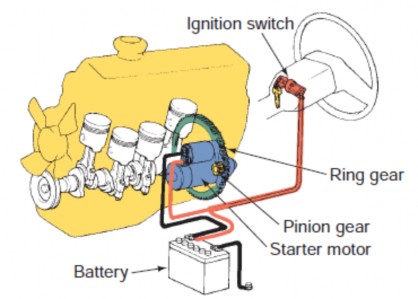
Figure 2.1 A typical starting system
The battery
The batteryis the big box that sits under the hood. It’s filled with acid and distilled water and has a set of plates inside it. The battery stores electric current for starting the car, turning on the lights, and powering the ignition system. It also stabilizes the voltage in the electrical system and provides current whenever the electrical demands exceed the output of the charging system.
The starter
After the battery sends the current to the starter solenoid, the current goes to the starter. The starter is the device that makes your engine start to work. It’s an electrical motor with a gear called a starter drive at one end. The starter drive engages a ring gear on a flywheelthat’s bolted to the back of the engine crankshaft. When you turn your key in the ignition switch, the starter drive slides down the shaft and engages the ring gear. This spins the flywheel, which starts the crankshaftturning so that the pistons can go up and down, the spark plugs can fire, and the engine can start running. As soon as the engine is started, the starter has done its job, and you should let go off the key.

